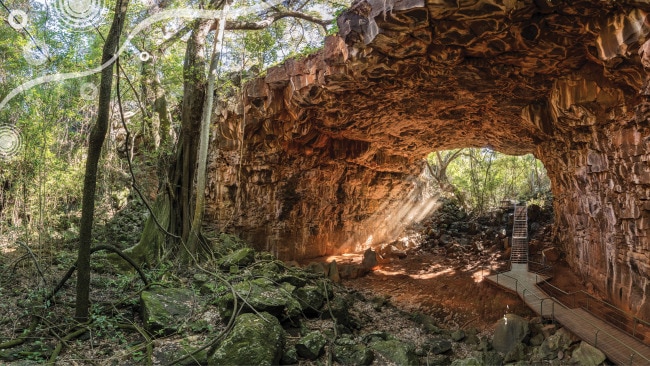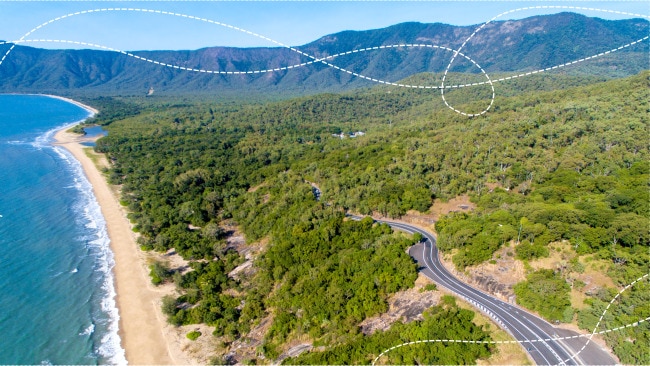Serious story behind megahit song
IT WAS made famous by the biggest song of 2016, but after the devastation of twin natural disasters, this tourist destination is struggling to survive.

Despacito — “slowly” — was the inescapable megahit of 2016, its catchy melody dominating the global charts, reaching a record-breaking nearly 4 billion views on YouTube and infiltrating our brains.
“This is how we do it down in Puerto Rico,” Luis Fonsi sang in Despacito’s lyrics, instantly putting Puerto Rico on the map and boosting tourism to the tropical island. Tour companies offered pit-stops to the iconic locations from the music video, including Club La Factoría in Old San Juan and brightly coloured buildings stacked alongside the beach in the La Perla region.
“What a joy it is to read this in international media,” musician Luis Fonsi wrote as a caption on his Instagram. “Puerto Rico is the true protagonist of this song and this video.”
When the Caribbean territory took a one-two punch from hurricanes Irma and Maria, people were worried about the impact on tourism and its economy. It was undeniably devastating.
But the good news is many islands in the Carribean were untouched by the storm, and most hotels sustained only minimal damage. Locals and volunteers banded together to help Puerto Rico get back on its feet and it reopened its doors to tourists much quicker than was expected. Today, all airports are open and operational and more than 1,885 restaurants are open around the island, including on Culebra and Vieques. Despacito might be the theme song to symbolise Puerto Rico’s recovery. Slowly, like the song’s namesake, the territory has rebuilt itself, with infectious spirit and optimism.
Just as Puerto Rican music has always reflected and shaped the diverse social elements and history; it’s the heart and soul of this place. Whether the beat is classical, bomba y plena, salsa, reggaeton, or new indie hits, music continues to shape and energise this U.S island territory.
DISCOVER BOMBA AND PLENA
One of Puerto Rico’s traditional Afro-Caribbean musical forms, bomba plays off of the musical energy between percussionists and dancers, culminating with an eventual rhythmic showdown. The music has its roots in Western Africa where slaves were taken and brought to the island, introducing a call-and-response lyrical style. Usually, a female voice called “laina” will start the song, with an energetic chorus as the response, supported by percussion instruments.
Originating in working-class neighbourhoods during the 1800s, plena is another Afro-Puerto Rican call-and-response folk music, but the lyrics tend to focus on the everyday struggles of the working class, a little like a local musical newspaper. Now more than ever, songs of resilience are important.
Visitors can explore this side of Puerto Rico’s rich African heritage at the San Juan’s Museo de las Américas, housed in the former military barracks of Old San Juan. Museum of Puerto Rican Music in Ponce also showcases historic Spanish, African, and Taíno (indigenous Caribbean) musical instruments, some of which can be played.
DANCE THE NIGHT AWAY WITH SALSA AND REGGAETON
Surrounded by postcard-perfect beaches, it would be easy to spend a holiday just taking a break and listen to the crashing waves. Condado Beach is a tourist favourite featuring big-name hotels and chain store smoothie joints while Flamenco Beach on Culebra Island or Sun Bay Beach south of Culebra on Vieques Island boasts pristine beaches only accessible off the beaten path. If you’re after a good surf break, near the town of Mayaguez on Puerto Rico's west coast is Rincon, serving up world-famous waves. Even when the surf's not up, its stretches of pristine beaches offer a peaceful, quiet atmosphere perfect for anyone wanting a quintessential beach bum holiday.
But if you’re after live music, capital city San Juan is the territory’s lively tourism hub. In UNESCO World Heritage Site Old San Juan, iconic Spanish-style apartments drenched in candy-coloured hues overlook the pristine beachfront. The heritage site is flanked by the imposing Castillo San Felipe del Morro, commonly known as El Morro, a fortress first constructed back in 1539, when Puerto Rico was under Spanish rule. Today it’s one of Puerto Rico’s most iconic tourist spots and the striking headland with surrounding sprawling grassy grounds attracts day trippers, picnickers and families flying kites. The lawn also hosts music concerts by various musical acts, which have in the past included the Symphonic Orchestra of Puerto Rico and the Greek pianist and composer, Yanni.
Calle del Cristo is one Old San Juan’s prettiest cobblestoned streets, lined with brilliantly coloured buildings guaranteed to up your Instagram game. The pina coladas are fresh (the cocktail’s birthplace, after all) and the smell of the region’s famous slow-cooked suckling pig lingers in the salty air. But more than anything, music is the beating heart that keeps this place pulsating more than any other island in the Caribbean.
Cuba may hold the title as the world’s capital of salsa music, but Puerto Rico certainly lives and breathes the genre; the territory has spat out talented salsa musicians such as Hector Lavoe, Tito Puente and Marc Anthony. If you’re keen to loosen those hips and unpack your dancing shoes, Nuyorican Café is legendary for its live Latino sounds and hip-gyrating locals. Early on in the evening, they even offer Latin dance classes. Musicians lke Pirulo, Willito Otero and Kalani Trinidad started their careers here, and today the bar provides two shows per night, usually buzzing by 11 pm.
La Placita is another major hub for nightlife in San Juan, and visitors are sure to hear Reggaeton blasting from nightclubs and bars. Blending Jamaican-style dance hall beats with hip hop raps in Spanish, this genre was made famous in the late ’90s by pioneers such as DJ Negro, Daddy Yankee, Don Omar and Wisin y Yandel and continued with artists like Luis Fonsi, who was the mastermind behind Despacito. Club Kronos boasts salsa, hip hop, reggaeton and electronic music nights while La Factoria offers a variety of chart-topping bangers paired with fresh, award-winning cocktails.
GET LOST IN FESTIVITIES
Puerto Rico keeps its rich musical traditions alive through its many festivals and street parties. So many, in fact, it’s quite easy to stumble across them by accident. There’s a high-spirited fiesta happening almost everywhere you look; this place has perfected the art of having fun.
San Sebastian Street Festival, or ‘SanSe’ as the locals call it, fills the streets with food stalls, the parada de cabezudos (parade of big heads), people walking on stilts, small music groups enthusiastically playing merengue, and enough booze to make a saint blush. Once the sun goes down, evening concerts draw a younger crowd to dance and sing until dawn.
Visitors can catch passionate salsa performances at Puerto Rico Salsa Congress at the end of July, an event together some of the world’s most talented salsa dancers and musicians. The Día Nacional de la Salsa is another massive celebration of salsa, featuring a lineup of big-name performances at the Hiram Bithorn Stadium.
Danza Week celebrates native Danza music, a genre heavily influenced by French and Cuban musical styles, paired with a popular turn-of-the-twentieth-century ballroom dance, slightly similar to the waltz. Less structured than the traditional waltz, Danza features a lead dancer who demonstrates the movements and steps. Known as the dance of the elite, watching well-dressed and groomed couples swing in unison will keep a visitor entertained for hours.
Puerto Rico is a quiet achiever when it comes to jazz; it has spat out a couple of world-famous jazz and Latin jazz musicians like Ray Barretto, Eddie Gómez, and Juan Tizol. There are also a handful of jazz clubs in San Juan, the perfect respite for anyone wanting to escape the beating salsa. The jazz is really celebrated during the Puerto Rico Heineken Jazz Fest, which showcases up-and-coming jazz talents with a particular emphasis on Puerto Rican music styles and Latin jazz. The four-day event is commonly held in March at the Tito Puente Amphitheater in San Juan and will impress true-blue jazz fans.
For a more subdued tone, Casals Festival in San Juan celebrates the life and work of famous Puerto Rican cellist, conductor and composer Pablo Casals. The two-week event attracts high-calibre musicians and includes live performances from some of the world’s best classical musicians. Throughout the year, the Luis A. Ferré Performing Arts Centre hosts traditional and contemporary performances and is the performing home of the Orquesta Sinfónica de Puerto Rico. Larger concerts take place in the Coliseo Roberto Clemente, which can hold up to 10,000 people.
THE TIME IS NOW
Puerto Ricans are known for their warm hospitality, and this hasn’t changed. Thanks to Puerto Rico’s determination and spirit to rebuild quickly, the tropical island offers off-the-beaten track adventures, incredible food and white sand beaches, as always. And whether it’s classical, bomba y plena, salsa, reggaeton, or new indie hits, there will always be a bar, festival or live band providing a colourful soundtrack to your island holiday.



